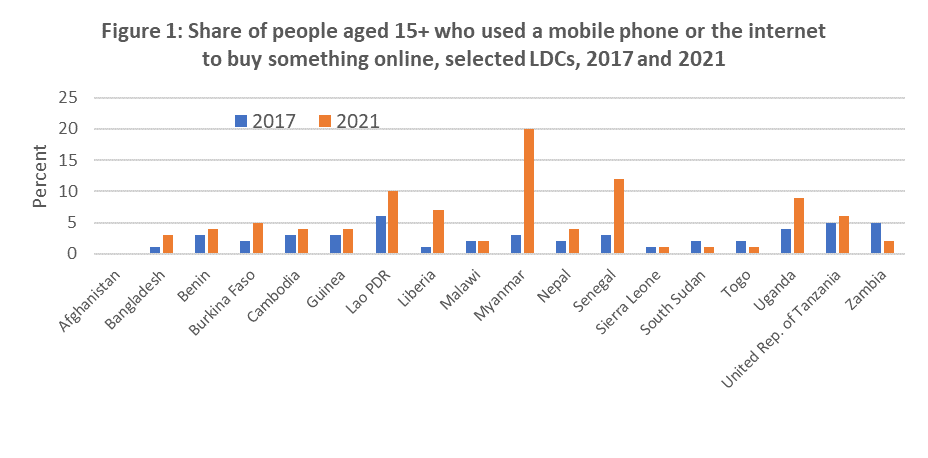
19 September 2022 / Torbjörn Fredriksson, Head of E-commerce and Digital Economy Branch, UNCTAD
During the COVID-19 pandemic, digital technologies have helped to mitigate some of its negative effects, to combat the virus and ensure the continuity of many economic activities. Lockdowns and other preventive measures that Governments have put in place to curb the spread of the virus have disrupted economic activity in ways for which societies were often unprepared. Amid the slowing economic activity, the pandemic led to a surge in e-commerce and accelerated digital transformation. While this transformation was already taking place, COVID-19 served as a catalyzer of digitalization.[1]
But countries are unevenly prepared for “going digital”. Due to persistent divides in infrastructural, technological and human capabilities, the accelerated shift towards greater reliance on digital solutions has in some respects resulted in wider rather than more narrow divides and inequalities. This is of particular concern to the least developed countries (LDCs).
There are multiple digital divides that need to be overcome. According to the International Telecommunication Union, about 27 per cent of people in LDCs used the Internet in 2021, compared with 90 per cent in developed countries. [2] And where connectivity exists in the LDCs, it is typically offered at relatively low bandwidth and with a relatively high price tag attached. For example, the average mobile broadband speed is about 3 times higher in developed countries than in the LDCs. And while more than 80 per cent of Internet users in Europe shop online, in many LDCs, fewer than 10 per cent do so.[3]
Recently released data from the World Bank’s Global Findex database sheds light on the extent to which LDCs have adopted e-commerce in the past few years (figure 1). For the 18 LDCs for which data exist, the picture varies. By far the largest increase in the share of adults who shopped online using a mobile or the internet between 2017 and 2021 was observed in Myanmar, where it surged from 3% to 20%. Other countries with significant increases include Senegal, Liberia, Uganda and Lao PDR. But for most of the countries, increases were limited and in some cases, the share even declined (South Sudan, Togo and Zambia).
In the area of trade, although global ICT goods trade has grown significantly during the pandemic, the LDCs as a group saw their exports and imports of such goods fall sharply. Similarly, the increase of the share of digitally deliverable services in total services exports was considerably smaller in LDCs than in more advanced economies.[4] In other words, LDCs in general have fallen further behind during the pandemic, raising the risk of widening inequalities. So, doubling the share of LDCs in world trade – as stipulated in Sustainable Development Goal target 17.11 – is likely to be even more difficult unless the ability of countries to participate in and benefit from digital trade is strengthened.
A multi-faceted challenge
To create more opportunities for LDCs to take advantage of the fast-evolving digital opportunities, it is essential to look beyond the connectivity aspect. Most LDCs lack sufficient financial, technical and other resources to capture value from digitalization. While significant advances in law adoption have been made since 2015 in many LDCs, the share of LDCs with relevant laws in data and privacy protection and consumer protection is still low (48 and 41 per cent, respectively).[5] In addition, the pandemic’s negative impact on economic growth has also strained public funds that might be available for developing capacities needed in multiple areas.
Coping with digitalization is particularly difficult for governments as the issues involved are cross-cutting in nature and thereby touch upon multiple government ministries. The speed at which technologies are evolving adds a further challenge for policy makers as they often find it hard to determine the most appropriate policy responses. In order to manage the risks and seize the opportunities associated with digitalization, including e-commerce, there is a need for a whole-of-government approach.
Many LDCs can benefit from international financial and technical support in this area. More resources are badly called for to help countries meet increasing financing needs at a time when fiscal space is shrinking and debt burdens are growing in many countries, making the mobilization of domestic resources even more difficult. Current financial support from the international community is far from enough, as shown in recent Aid for Trade commitments. UNCTAD calculations, based on OECD data, show that the share of Aid for Trade resources allocated to the ICT sector increased from 1.2 per cent in 2017 to 2.7 per cent in 2019 and remained unchanged in 2020. In absolute terms, the resources allocated to the ICT area rose by $300 million that year.[6]
Assessing and enhancing eTrade readiness
The scale and complexity of this challenge require new forms of international collaboration. At the United Nations Conference on Trade and Development (UNCTAD), we have identified two main problems to address. The first concerns the limited readiness of many developing countries to engage in and benefit from e-commerce and the digital economy. The second relates to insufficient and ineffective support from the international community to address issues related to the digital economy.
One response to the first problem is UNCTAD’s eTrade Readiness Assessments, launched in 2017. While awareness of the importance of digitalization is growing, many governments are struggling to determine what measures to take first to strengthen a country’s digital readiness. Without a clear understanding of the priorities, it is difficult for a government to indicate the type of support that might be sought from development partners. This has sometimes been mistakenly interpreted as a lack of demand for development assistance in the digital area.
Each eTrade Readiness Assessment reviews the state-of-play of the e-commerce enabling environment in the country and provides specific recommendations on how to address existing weaknesses through concrete actions on the ground.[7] As of August 2022, a total of 32 such assessments had been completed, 24 of which are LDCs (covering 15 of the LDCs included in figure 1). Support for the implementation of the recommendations contained in the assessments is provided through an Implementation Support Mechanism (ISM).
The extent to which LDC governments are acting upon the recommendations contained in the assessments varies considerably. Our follow-up analysis confirms Cambodia as the top-performer, with an implementation rate of 92 per cent of all recommendations, followed by Bhutan, Senegal and Togo (all standing at 81 per cent). In Cambodia, the Ministry of Commerce recognizes the catalytic role played by the eTrade Readiness Assessment for several government initiatives in support of the e-commerce ecosystem. One recommendation prioritized by the Royal Government of Cambodia was to develop a national E-commerce Strategy. The growing importance of e-commerce in the South-East Asian nation has also prompted the Government to develop a Digital Economy and Society Policy Framework 2021-2035, which sets out a long-term vision to build a vibrant digital economy and society. But as indicated in figure 1, uptake of e-commerce in Cambodia was still limited in 2021.
In following up on the recommendations, each assessment identifies potential partners that could offer technical support if needed. For example, UNCTAD has partnered with several LDCs to develop a national e-commerce strategy (Benin, Myanmar, Rwanda, Solomon Islands), to strengthen the legal and regulatory framework for e-commerce (in ASEAN and EAC), empower women digital entrepreneurs in LDCs (e.g. in Rwanda), and boost the capacity to measure e-commerce and various aspects of the digital economy (e.g. in the Pacific). And if UNCTAD does not have the expertise required, the assessments will point to other partnering organizations that may be in a better position to support them. Many of them are members of the eTrade for all initiative.
To respond to the second problem mentioned above, UNCTAD in 2016 launched eTrade for all. It is a global initiative of 35 partners (September 2022) that seeks to connect the dots among organizations, donors and beneficiaries to foster more inclusive e-commerce development. By reaching beyond sector-by-sector silos and taking a comprehensive approach to various policy challenges that countries are facing when they develop their e-commerce ecosystems, the initiative seeks to facilitate more inclusive development outcomes. Its online platformOpens a new window serves as a single gateway to organizations offering technical assistance and capacity building related to e-commerce in English, French and Spanish, and allows potential beneficiaries to connect directly with any offering partner.
More is needed
As countries gradually and unevenly emerge from the pandemic, a return to business as usual is no longer an option. Work, education, entertainment and communications are likely to be more dependent on digital technologies than before. This accentuates the need for public policies that can maximize opportunities and address challenges and concerns related to digitalization, including policies and regulations that ensure that the digital economy works for the benefit of people and the planet.
In this context, there will be a need for more rather than less coordination and collaboration. The eTrade for all initiative, with its focus on information sharing to leverage the strengths of different actors, has enhanced mutual understanding of what each partner is doing and where there are opportunities for synergies.
Given the urgency to bridge the gaps in digital capabilities and the insufficient levels of development assistance, development organizations (including the Technology Bank) and bilateral donors, will need to develop new and innovative ways of working together. It takes time to develop and implement solutions for improving legal and regulatory frameworks to enhance trust online, building skills for the digital economy, strengthening women’s digital entrepreneurship and facilitating digital financial inclusion.
[1] See e.g. https://unctad.org/system/files/official-document/tdb_ede5d2_en.pdfPDFOpens a new window
[2] See e.g. https://www.itu.int/en/ITU-D/Statistics/Pages/stat/default.aspxOpens a new window
[3] See https://unctad.org/webflyer/digital-economy-report-2021Opens a new window
[4] UNCTAD (2021). Impacts of the COVID-19 Pandemic on trade in the digital economy. UNCTAD Technical Notes on ICT for Development No. 19. https://unctad.org/system/files/official-document/tn_unctad_ict4d19_en.pdfPDFOpens a new window
[5] https://unctad.org/system/files/official-document/dtlstict2022d1_en.pdfPDFOpens a new window
[6] See https://unctad.org/system/files/official-document/dtlstictinf2022d2_en.pdfPDFOpens a new window
[7] For more information, see https://unctad.org/topic/ecommerce-and-digital-economy/etrade-readiness-assessments-of-LDCs
Source: https://www.un.org/technologybank/news/ldc-insight-4-strengthening-digital-capacities-least-developed-countries-even-more-urgent-post






 en
en




 Guangzhou,China
Guangzhou,China +86 - 19925740779
+86 - 19925740779 wedc@vip.126.com
wedc@vip.126.com










